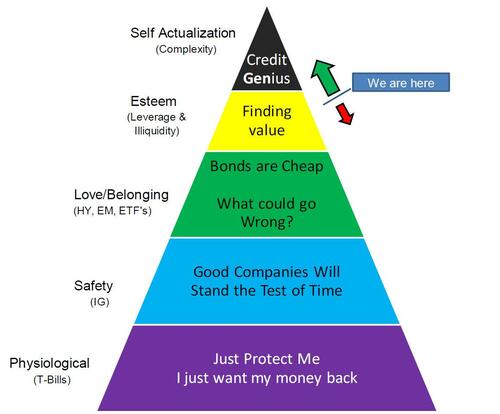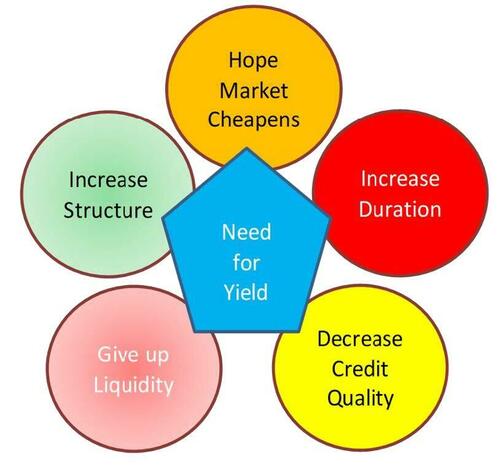


By Peter Tchir of Academy Securities
This is a piece that we’ve been meaning to get to for the past few weeks, but this weekend seemed like an ideal time:
Getting right to the point (which should be obvious with the IG 20 comment), I’m quite bullish credit, for a variety of reasons!
For me, if I’m going to talk about how much tighter credit can go, I might as well start with the tool I use to think about bubbles.
I find that credit investors conform quite nicely to this model. Investors move up and down the model as they either crave (need) risk or grow fearful and shed risk.
I see many signs that we are moving up the risk-taking spectrum. We are well beyond the Love/Belonging phase and well into Esteem. Which for me, in credit, means leverage and illiquidity. Private credit is quite literally the definition of illiquidity. I’m hearing of more ways to incorporate leverage into transactions and certainly more investors are being pulled into the structured space.
We are not yet in the “Credit Genius” phase where products like Leveraged Super Senior (LSS) and CPDO (Constant Proportion Default Obligations) are the name of the game. While the scars of the Great Financial Crisis and even the European Debt Crisis are still too fresh to propel us into this rarified space, we are heading in that direction.
This is where it is important to emphasize that direction of travel is important. So long as we are moving up the pyramid, spreads tighten. Each new innovation/investor into a space pushes spreads tighter in that space. It can become a self-reinforcing trade, as tighter spreads cause more “chasing,” pushing spreads tighter.
I think it was in June 2007 that spreads hit their tightest. CDX could be traded in billions in locked markets and the spread was below 30 (if memory serves correctly). LCDX was all the rage. The fact that the mortgage market was in some degree of disarray, and the fact that we were months away from some large banks (and broker dealers, because we had actual non-bank broker dealers back in 2007) having to cut their dividend didn’t stop us from reaching these new tights. The complexity is very dangerous when/if it starts to unwind, but it is a party on the way to being a “Credit Genius.”
This is a good segue into the “companion” chart of Maslow’s Hierarchy of a Credit Bubble. The 5 Circles of Bond Investor Hell.
If you’ve traded bonds for any length of time, you’ve probably found yourself trapped in one or more of these circles. Basically, as credit spreads remain tight, there are only a few options investors have. You can “Hope the Market Cheapens” but most of us aren’t paid to sit on our hands, and after almost 6 months of spreads grinding tighter, it is difficult to stay in this circle. “Increasing Duration” doesn’t help much on the yield side, with curves remaining inverted, but it does help on credit. “Decreasing Credit Quality” is often a difficult one, as you may have mandates restricting this, but there comes a time when investors have to move in this direction to get yield. “Giving up Liquidity” seems to be the “go to” circle these days. It makes sense, especially as so many investors (like insurance companies) have tax/regulatory reasons that they cannot fully utilize liquidity in any case. “Increasing Structure” has always made the most sense to me (I’m a geek at heart) because it seems like with some additional work, you can capture spread from others who haven’t done the work. Adding some “modelling” capability can let you generate alpha, so it is a natural evolution. It is also an area where I think we could safely argue that rating agencies (technically the Nationally Recognized Statistical Rating Organizations - NRSROs) have required more and more subordination and structural advantages. The same rating now, as compared to pre-crisis, is likely far safer.
It is these “circles of hell” that feed the upward (and sometimes downward) movement within Maslow and I see no reason for it not to continue to push people more and more into risk, with structured risk and giving up liquidity being the main destinations.
Borrowing from Shakespeare, “I come not to praise Private Credit.” I am very much a fan of private credit. As of yet, I don’t see the industry as a whole pushing the boundaries too far. I do believe that most investors understand the liquidity constraints, and the default risks they are taking. I don’t see excessive leverage in the deals themselves or in how investors are accessing this market. But this isn’t the time or the place for me to go all “Mark Antony” on Private Credit, which I could do, as I like it. However, I would prefer to highlight why I think it will be important in the further tightening of overall credit spreads.
For now, private credit has been helpful for credit spreads, and with banks back competing, I see no reason for that trend not to continue. At some point private credit might be an issue, but it isn’t high on my list of potential risks (remember I tend to think Bubbles start with “Safe Assets”).
I’ll be brief, as I’ve already touched on some of these issues, but it is important:
Basically, for structured and high yield, I’m comfortable that long-term charts on spreads are misleading as the current markets are “safer” than they were historically, meaning that they can sustain (and deserve) better spreads.
Why can’t credit spreads compress further as the U.S. government does two things:
Just look at “governance.” While many of the biggest issuers are “U.S.-based” they are, in reality, global enterprises. They operate across the globe in a myriad of jurisdictions. Many have cash. Most have leaders and boards that are well aware of their fiduciary responsibilities, including to bondholders (Year of the Debt Diet). Why not overweight corporate credit versus government debt?
We are all used to thinking about T+X for corporate bonds. Where X is the credit spread. But what makes up that credit spread? What is X really composed of?
I would argue that as people get forced to look at the circles of bond investor hell, they might decide that corporate credit, even at today’s “tight” levels, has the potential to go much tighter, especially as some of the biggest borrowers stack up favorably versus even the “safest” of issuers (the U.S. government).
A few quick thoughts:
I’m not sure I brought up a single geopolitical or economic argument in favor of tighter credit spreads, but I think, to the frustration of many, that we will see another leg tighter across the board in credit.
Back to the original question, “How Tight can Credit Spreads Go?” – I think we can get into the 30s on CDX IG, and corporate bond spreads will also get to the tightest levels since the GFC, which seems only fitting with stocks at all-time highs.


